When you’re putting together copy for a website you may not have the luxury of only having to speak to one audience. In fact, you may have multiple audiences you need to address.
Which means you’ve got a juggling act on your hands.
Who is most important? What if both audiences require equal attention? How do you write copy that attracts more than one audience on a page without confusing your messaging?
The answers to these questions lie in your customer research and a process for determining where your audiences’ needs overlap.
Table of contents
Always start with your research
Before you can begin writing, you need to know who you’re writing for and what drives their behavior. I’ve written exhaustively on the blog about how to develop customer personas and conduct voice of customer research, both when you have customers and when you don’t. So, I won’t get into the nitty gritty details behind those processes again.
Suffice it to say, you’ll want to dive into your qualitative and quantitative data from your research in order to understand what makes your primary audiences tick.
Through on-site and off-site surveys, interviews, focus groups, and your Google Analytics pull out key pieces of information that tells you about your audiences’:
- Goals – These include the actions people are looking to take. What do your audiences want to accomplish while on your site? For instance, someone who wants to volunteer for your nonprofit has distinct goals from someone else who only wants to donate.
- Needs – The benefits from using your product or service will differ depending on your audience. Determine what each audience values and how the people in it want their lives to be like after buying from you. A young stay at home mother of two may be more interested in convenience and affordability while a college student cares about how technically innovative your product is.
- Expectations – Different audiences will expect different experiences when they visit. What are your audiences hoping to find when they arrive on your site? A vendor looking to set up a shop on Etsy isn’t going to be as concerned with the browsing experience as a casual shopper.
Once you’ve determined the what and why behind your audiences, you can start to think about how you’re going to talk to each on the same page.
Tell your audiences what’s in it for them in your value proposition
When you have more than one audience to address on a page, figure out where the benefits each audience gets out of the business, product, or solution overlap.
To do this, simply list out what each group values the most.
For instance, the startup Quadjobs (that I’ve written about previously) has two distinct audiences they need to attract: employers and students. Here’s what the lists for each group look like.
| Employers | Students |
|---|---|
|
|
Compare the two lists and it’s simple to find the overlap. Both audiences value flexible hours, ability to connect with one another easily and get/post a range of job sizes.
From here, it’s a matter of crafting a headline and sub-headline that incorporates the wants of both groups while making sure to key those audiences into what’s unique about Quadjobs.
Find Hardworking College and Graduate Students
To Tackle Your Jobs Big and Small
Easily connect with smart and flexible help right in your community
In this case, I framed the copy from the perspective of the employers because they are the ones directly driving revenue to the site. But, you could just as easily have made the focus on the students or emphasized both equally.
Joanna Wiebe over at CopyHackers illustrates how to find the overlap in what your various audiences value with a Venn diagram. Just like connecting the dots in your lists, the diagram makes it obvious where you can find common ground.
Here’s what she says about the process in her post:
“When I’m helping my startup clients with this issue, I ask them to create a Venn diagram in which the values X, Y and Z audience derive from your product are listed, and the similarities overlap.
With that Venn diagram complete – and you know it wouldn’t take you long to do – you can then craft a single home page headline that speaks to both audiences…”
This is what she came up with for the above example:
Where App Developers & App Sellers Make More Money & Generate More App Installs
In this instance, you can see where both audiences are on equal footing in the headline. It’s clear, simple, and gives visitors from each group two very compelling reasons to keep reading.
Ways to structure your copy on the page for more than one audience
Once you’ve keyed your audiences into the fact that they’ve landed in the right place and given them a reason to keep reading down the page, now it’s time to sort out the rest of the page’s copy.
There are generally three scenarios you’ll run into:
- One audience takes precedence over another.
- Two audiences get equal billing.
- More than two audiences requires attention.
#1: One audience takes precedence over another
In this scenario, the copy focuses almost entirely on one audience. I helped the folks at Fun Pasta rework their home page to gear it towards the interests of fundraising organizers. While supporters (people buying products online during fundraisers) make up their other key audience, we kept them mostly absent from the home page other than in the top navigation.
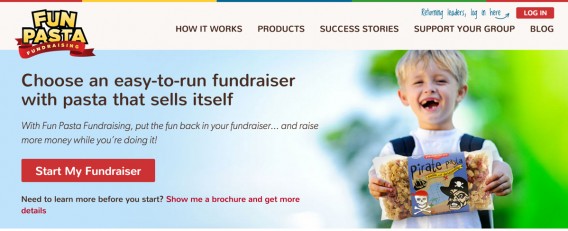
The shopping app, Wanelo, follows a similar path with their vendors being subordinated to a button in the top right hand corner. Like Fun Pasta, the main call to action and subsequent copy down the page makes it clear the home page is all about attracting the primary audience first.

When should you give one audience precedence over another?
Consider giving one or more of your audiences a backseat on the page when:
- Your website goals clearly favor one audience over another – With the Fun Pasta home page, our main goal is to encourage fundraisers to either sign up. Short of that, we want them to become leads. Sale of the products depends on fundraisers driving supporters to the site to buy products. So, it’s critically important to speak to them directly.
- One audience is a primary user – Your analytics data can give you an indication of who uses your site the most and what actions are being taken. In the case of Wanelo, 11 million people use the site to shop and explore new items. As of 2013, those shoppers were spending an average of 50 minutes a day on the site. Tailoring the content to their needs makes sense.
#2: Two audiences get equal copy billing
If you’ve got two groups who require equal billing, you’ll want to differentiate on the page sections devoted to information designed to appeal to one group versus another.
Let’s take a look at Quadjobs again. They manage to do this by essentially dividing the page in half with the key benefits and call to action for employers on the left and students on the right.
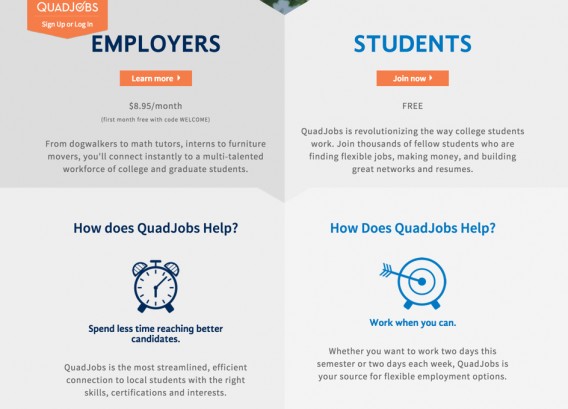
Nestio’s home page works in a similar way but keeps the copy to a minimum with only a singular benefit under each audience call to action.

Essentially, this page acts as a kind of short form landing page directing each group immediately to their own dedicated landing page with a series of benefits, features, and pricing plans.
And then there’s Freelanship, another cool startup connecting students with employers, that uses a simple and short home page to funnel its audiences further into the site.

When should you give 2 audiences equal billing?
You’ll want to focus your attention on writing for both audiences when:
- Your website goals don’t clearly favor one audience over another – As a startup, Quadjobs has needed to attract and convert both employers and students at the same time. When the business isn’t in the position of having an existing user or customer base, emphasizing one audience may not be feasible.
- Both audiences routinely enter the site on the same page – In the case of the Fun Pasta website, we knew that supporters generally bypass the home page. They are sent to specific product links or their group’s page directly. If you have a site where it’s clear from your analytics that both sets of visitors make their primary entry point on the same page, you’ll want your copy to reflect that fact.
#3: More than two audiences require attention
Sometimes you’ve got more than two audiences to address on a page. When this happens, you’ll want to consider immediately giving people options of where to go based on what they want to accomplish or prioritizing the audiences with the most important being mentioned higher up on the page.
Nonprofits are classic examples of organizations that must speak to multiple audiences on their websites. Take a look at the home page for Oxfam America and you’ll see how they attempt to funnel website visitors using the call to actions “Volunteer,” “Take Action,” and “Donate Now.”
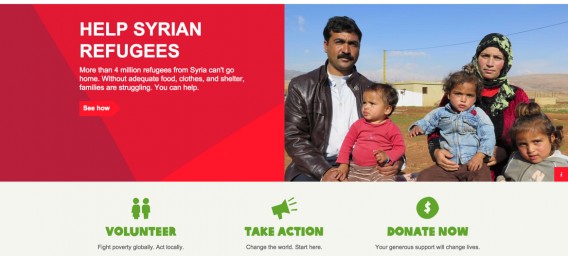
Each call to action encourages visitors to self-select based on the action they want to take.
In a similar way, the nonprofit Charity Water gives visitors the option to identify with the action they want to take versus a defined audience name.

Charity water begins walking visitors through the campaign process from just above the fold on the home page. As you scroll down the page, you’re introduced to the idea of becoming a sponsor or a donor.
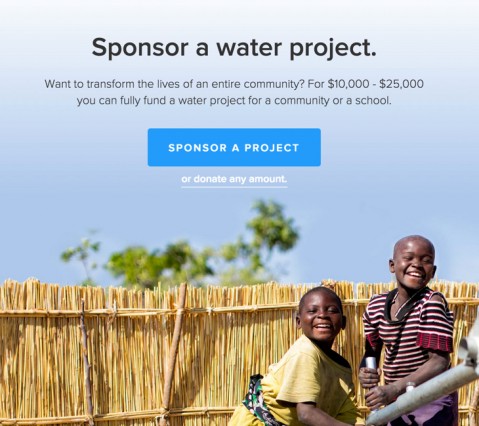
Clearly, the emphasis has been placed on starting a campaign with the first ⅔ of the home page copy devoted to that action and the benefits of doing so.
Sponsoring a project and donating any amount have been subordinated to positions further down the page either because less visitors are interested in taking those actions or the charity would prefer to get more people on the campaign bandwagon.
When should you address multiple audiences on a page?
Again, you’ll want to look at your organization’s goals on the site. For many nonprofits, the health of the organization is dependent on not only fostering relationships with donors but bringing in volunteers and engaging with those in need.
This means making it simple to locate the information each audience needs to make a decision to take action (on a home page in particular) is critical.
A word about your copy and helping visitors identify with their audience
The Nielsen Norman Group recently posted an article about the problems associated with basing navigation on audience types. While the focus here hasn’t been on navigation, there’s a few interesting takeaways from the Nielsen piece that can be applied.
As with many of the examples I share, the businesses give visitors the option to self-identify with an audience based on its type – i.e. employers, brokers, vendors, etc. One of the biggest problems with this is the fact that user experience can suffer if the language isn’t entirely clear to the audience member.
If an individual wants to hire a student to clean up her yard, will she identify herself as an “Employer” on the Quadjobs site? That person may find the label confusing; thereby increasing anxiety and cognitive load.
One way to minimize this problem is by either segmenting your audiences by the actions they most want to take (as in the case of Charity Water and Oxfam). Or, you can use a qualifier in front of the audience name.

Wharton’s executive education website does this with its Programs for Individuals and Programs for Organizations. There’s less ambiguity as to what you’ll find on the other side of those buttons, decreasing the confusion factor.
Conclusion
When you’ve identified more than one audience to address on a page, you’ll want to spend some time on the following before you start writing:
- Look at your qualitative and quantitative research to determine exactly who makes up your audiences, what drives their behavior, and what they want to accomplish on your site.
- List what each audience values the most from your product or solution and see where there’s overlap
- Use those commonalities among audiences to help construct a value proposition geared towards moving your visitors down the page
- Consider your business and website goals in conjunction with your audience goals when crafting your copy and laying out the page
- Make sure whatever labels you use for your audiences, they are clear and straightforward so that it’s easy for visitors to self-identify
Have you had the challenge of writing for two or more audiences? If so, let us know the solutions you’ve come up with to effectively juggle all of them.


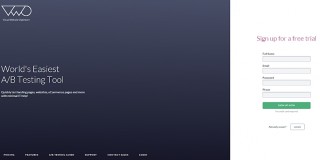



Fantastic writing tips
This is a fantastic breakdown! Thanks for sharing!
Your article is great for businesses that only have two audiences. What about law firms that offer many different services i.e. personal injury law, employment law, family law, first nations law, administrative law, corporate commercial law, civil litigation law, criminal law, labour and employment law, real estate law, construction law, mining law and wills and estates law. These areas of practice are taken from a real law firm that offers all these law services. How would you ever write an effective headline and value proposition that works for all these different audiences?
I’ve had to write for companies that have multiple solutions and/or audiences and it’s difficult. In that case, you’ll want to consider a headline and value proposition that speaks to the overall strengths of the firm and why people seek it out (if you can find a common reason such as reputation for getting results or client support.) Then, it’s a matter of making it easy for people to take action depending on what they want to do on the site.
Jen – I suspect that creating a headline and value proposition that speaks to the overall strengths of a company that offers multiple services will be very weak compared to writing a headline for a law firm that specializes in only one area of law.
You mention “that it’s a matter of making it easy for people to take action depending on what they want to do on the site.” For my law firm example that provides services for 13 different areas of law, how would you accomplish this on their homepage? Each of these audiences will have different needs.
Without looking at your site, doing some research, and digging into your analytics, it’s difficult for me to give you specific recommendations. However, I would make sure your navigation is intuitive – meaning if you have multiple drop down menus it will make sense to the average user where he might find the area of law he’s interested in. As far as the value proposition is concerned, the more specific and clear you can be the better. Yes, a firm that only specializes in one area of law will be able to tailor its messaging to a defined niche. And, it’s far easier to write for one audience. I’d take some time to determine how many audiences you truly have. Is there one type of client that engages your firm across multiple areas? You may be able to approach your messaging from this angle.
Jen – Yes I agree having intuitive drop down navigation is important.
How about keeping the homepage short and quickly driving each group to its own targeted landing page? This could be accomplished by displaying the various areas of law immediately below the value proposition. Each law section would include a short title and description written specifically to engage that audience.
Hey Jennifer. First of all, thank you for this article. It’s a good read. When it comes to writing a copy, I’d like to say that it is important to know who you’re writing for. There are different types of customers and behaviours – that’s why you need to tailor the copy for every group. But that doesn’t mean one page = one group. For example, you have a person who wants to know the essentials and the one who would rather read more about your product. The solution? Write the essentials above the fold and the rest below. It’s gonna satisfy both users.
If you’d like to take a look at the article concerning optimal landing page copy length, here it is: http://bit.ly/1KrFRYp. I hope it comes in handy!